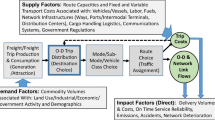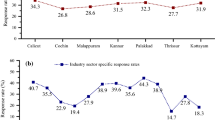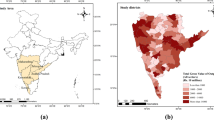Abstract
Freight modelling is very important to understand how freight moves from one place to another place. Due to data and other resource constraints like time and cost of conducting surveys, freight models are not available for various countries. Overcoming these constraints, freight generation and distribution models are developed using secondary sources of data. The primary motivation of the study is to understand the different factors on which freight generation depends upon. This is accomplished by building ordinary least squares regression models. Net State Domestic Product, Area, Agricultural Area, Secondary sector workers, Petroleum and Electricity Consumption of the Traffic Analysis Zones are the factors that affect freight generation. The secondary motivation of the study is to estimate the friction factors for the gravity model by calibration using three-dimensional furness procedure, being used for the first time in freight distribution. The important contributions of this paper are an improved understanding of freight movement patterns at the regional level and the estimation of friction factors that can be used for predicting future freight movements when origin–destination data are not available.



(data source: TTSS-RITES Ltd., 2008)







Similar content being viewed by others
Notes
65.2% in 1978–1979 to 32.2% in 2007–2008 (Total Transport System Study 2007–2008).
RITES Ltd. [1] estimates that the total loss incurred on transportation in financial year 2007–2008 amounts to ₹384.7 billion.
Conducted nationwide every five years in United States to obtain the data pertaining to freight corresponding to various commodities generated from or attracted to a geographic area, usually a county.
References
RITES Ltd. (2007) Total transport system study. New Delhi
National Transport Development Policy Committee (2014) India transport report: moving India to 2032: volume 1: executive summary. Routledge, New Delhi
Ben-Akiva M, de Jong G (2013) The aggregate-disaggregate-aggregate (ADA) freight model system. In: Freight transport modelling. Emerald Group Publishing Limited, Cambridge, pp 69–90
United States Department of Transportation, Research, Innovative Technology Administration, National Cooperative Freight Research Program, Cambridge Systematics, GeoStats LLP (2010) Freight-demand modeling to support public-sector decision making, vol 8. National Academies Press, Washington, D.C
Bovenkerk M (2005) SMILE+: the new and improved Dutch national freight model system. In: European transport conference, Strasbourg, 3–5 October 2005
Comi A, Donnelly R, Russo F (2014) Urban freight models. In: Modelling freight transport. Elsevier, pp 163–200
Holguín-Veras J, Jaller M, Sanchez-Diaz I, Wojtowicz J, Campbell S, Levinson H, Lawson C, Powers EL, Tavasszy L (2012) Freight trip generation and land use, No. NCHRP Project 08-80
Horowitz AJ (2006) NCHRP Synthesis 358: Statewide travel forecasting models. Transportation Research Board
de Jong G, Vierth I, Tavasszy L, Ben-Akiva M (2013) Recent developments in national and international freight transport models within Europe. Transportation 40:347–371. https://doi.org/10.1007/s11116-012-9422-9
Marzano V, Papola A (2004) Modelling freight demand at national level: theoretical developments and application to italian demand. European Transport Conference Strasbourg, pp 1–18
Sivakumar A, Bhat C (2002) Fractional split-distribution model for statewide commodity-flow analysis. Transp Res Rec J Transp Res Board 1790:80–88. https://doi.org/10.3141/1790-10
Yang Y (2015) Development of the regional freight transportation demand prediction models based on the regression analysis methods. Neurocomputing 158:42–47
Brogan JJ, Brich SC, Demetsky MJ, Board VCT (2001) Application of a statewide intermodal freight planning methodology, No. VTRC-02-R5. Virginia Transportation Research Council
Hancock KL (2008) Freight demand modeling: tools for public-sector decision making. Transportation Research Board, Washington, D.C.
De Jong G, Gunn H, Walker W, Widell J (2002) Study on ideas on a new national freight model system for Sweden. RAND, Santa Monica
Kulpa T (2014) Freight truck trip generation modelling at regional level. Procedia Soc Behav Sci 111:197–202. https://doi.org/10.1016/j.sbspro.2014.01.052
Ashtakala B, Murthy ASN (1988) Optimized gravity models for commodity transportation. J Transp Eng 114:393–408. https://doi.org/10.1061/(ASCE)0733-947X(1988)114:4(393)
Evans SP, Kirby HR (1974) A three-dimensional furness procedure for calibrating gravity models. Transp Res 8:105–122. https://doi.org/10.1016/0041-1647(74)90037-9
Mao S, Demetsky MJ (2002) Calibration of the gravity model for truck freight flow distribution, No. UVACTS-5-14-14. Pennsylvania Transportation Institute, Pennsylvania State University
JD Ortúzar, LG Willumsen (2011) Modelling transport. https://doi.org/10.1002/9781119993308
Rwakarehe EE, Zhong M, Christie J (2014) Development of a freight demand model for the province of Alberta using public sources of data. Procedia Soc Behav Sci 138:695–705. https://doi.org/10.1016/j.sbspro.2014.07.263
Shinghal N, Fowkes T (2002) Freight mode choice and adaptive stated preferences. Transp Res Part E Logist Transp Rev 38:367–378. https://doi.org/10.1016/S1366-5545(02)00012-1
Tavasszy LA, Ruijgrok K, Davydenko I (2012) Incorporating logistics in freight transport demand models: state-of-the-art and research opportunities. Transp Rev 32(2):203–219
Tavasszy L, De Jong G (2013) Modelling freight transport, 1st edn. Elsevier, London
Pendyala RM (2006) Modeling freight travel demand using a structural equations modeling framework. University of South Florida
Tavasszy L, Davydenko I, Ruijgrok K (2009) The extended generalized cost concept and its application in freight transport and general equilibrium modeling. In: Integration of spatial computable general equilibrium and transport modelling bilateral joint seminar under agreement between NWO and JSPS
Zhao Y, Kockelman KM (2004) The random-utility-based multiregional input–output model: solution existence and uniqueness. Transp Res Part B Methodol 38:789–807. https://doi.org/10.1016/j.trb.2003.10.005
Bilegan IC, Crainic TG, Gendreau M (2008) Forecasting freight demand at intermodal terminals using neural networks—an integrated framework. Eur J Oper Res 13:1–6
Williams I, Jin Y, Deane G (2005) Regional pilot for economic/logistic methods the EUNET2.0 freight and logistics model—final report, p 44
TetraplanAS (2009) Traffic flow: scenario, traffic forecast and analysis of traffic on the TEN-T, taking into consideration the external dimension of the union. Final report
Korzhenevych A (2012) TRANS-TOOLS–an integrated support tool for European transport policy. Information zur Raumentwicklung 7/8:349–366
Ambrosini C, Gonzalez-Feliu J, Toilier F (2013) A design methodology for scenario-analysis in urban freight modelling. Eur Transp 54(7):1–21
Bröcker J, Korzhenevych A (2013) Forward looking dynamics in spatial CGE modelling. Econ Model 31:389–400. https://doi.org/10.1016/j.econmod.2012.11.031
TML (2007) Final report TREMOVE. 1: European Commission, Belgium
Bröcker J, Schneekloth N (2005) European transport policy and cohesion—an assessment by CGE analysis
Divya Priya C, Ramadurai G, Devi G (2015) Freight trip generation models for Chennai, India. Transportation Research Board 94th Annual Meeting Washington, D.C, pp 1–13
Patil GR, Sahu PK (2016) Estimation of freight demand at Mumbai Port using regression and time series models. KSCE J Civ Eng 20:2022–2032. https://doi.org/10.1007/s12205-015-0386-0
Sahu PK, Patil GR (2015) Handling short run disequilibrium in freight demand forecasting at major Indian ports using error correction approach. Eur Transp Trasp Eur 1–19. https://doi.org/10.1007/s12205-015-0386-0
Patil GR, Sahu PK (2017) Simultaneous dynamic demand estimation models for major seaports in India. Transp Lett 9:141–151. https://doi.org/10.1080/19427867.2016.1203582
Chandrasekhar BP (1984) Development of highway freight transportation demand model for a region with application to Hyderabad area. Kakatiya University, Warangal
RITES Ltd. (2007) Preliminary engineering-cum-traffic study. New Delhi
Ministry of Statistics and Programme Implementation (2015) Overall balance of payments, open government data platform India. https://data.gov.in/catalog/overall-balance-payments. Accessed 14 Jul 2016
Ministry of Petroleum and Natural Gas. http://petroleum.nic.in/. Accessed 15 Jul 2016
Power and Energy Division of the Planning Commission of India. http://planningcommission.nic.in/sectors/index.php?sectors=energy. Accessed 14 Jul 2016
Casey HJ (1955) Applications to traffic engineering of the law of retail gravitation. Traffic Q IX:23–35
Bacharach M (1970) Biproportional matrices and input–output change, vol 16. CUP Archive, Cambridge
Acknowledgements
Most of the data utilized in this study were obtained from the website of the Planning Commission of India and the authors would like to acknowledge it. Also, the authors acknowledge the opportunity to present the research work that forms the basis of this article at the 12th Conference on Transportation Planning and Implementation Methodologies for Developing Countries (TPMDC) (India) held during 19–21 December 2016. They thank the reviewers for the comments on the manuscript which helped them in improving the paper.
Author information
Authors and Affiliations
Corresponding author
Ethics declarations
Conflict of interest
The authors declare that they have no conflict of interest.
Electronic supplementary material
Below is the link to the electronic supplementary material.
Rights and permissions
About this article
Cite this article
Middela, M.S., Pulipati, S.B. & Prasad, C.S.R.K. Modelling Freight Generation and Distribution for Nationwide Interstate Freight Movement. Transp. in Dev. Econ. 4, 6 (2018). https://doi.org/10.1007/s40890-018-0059-z
Received:
Accepted:
Published:
DOI: https://doi.org/10.1007/s40890-018-0059-z




